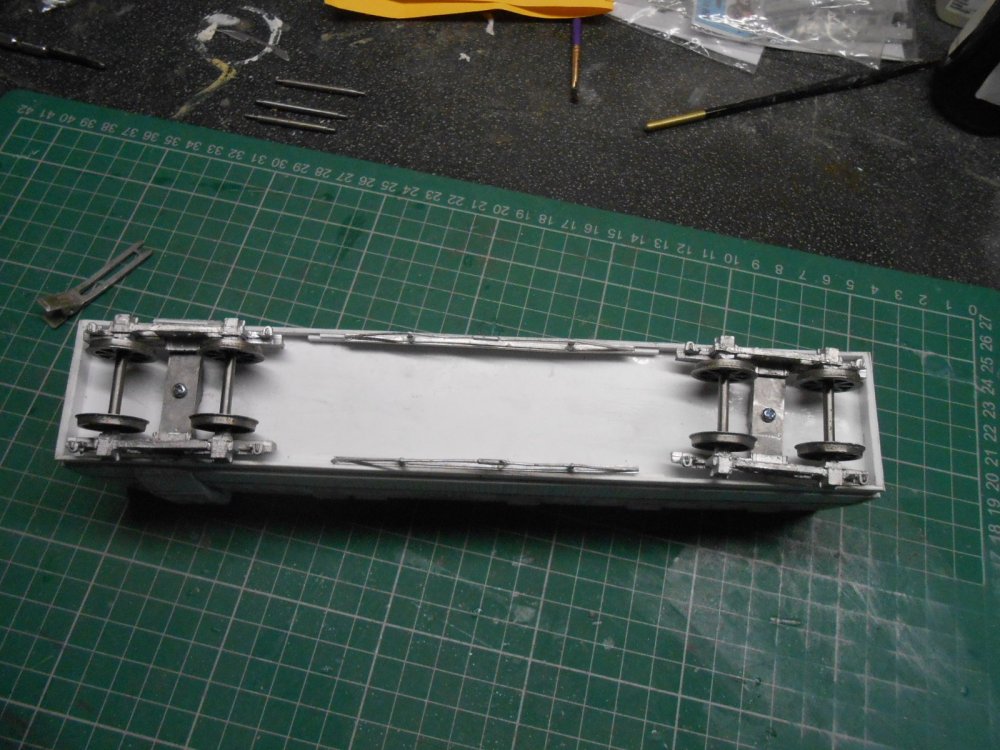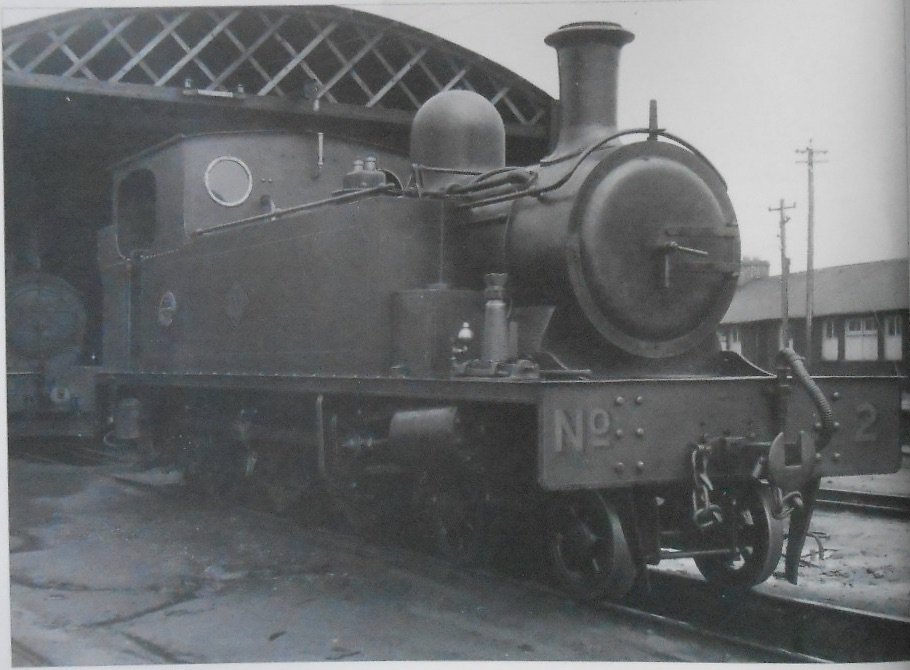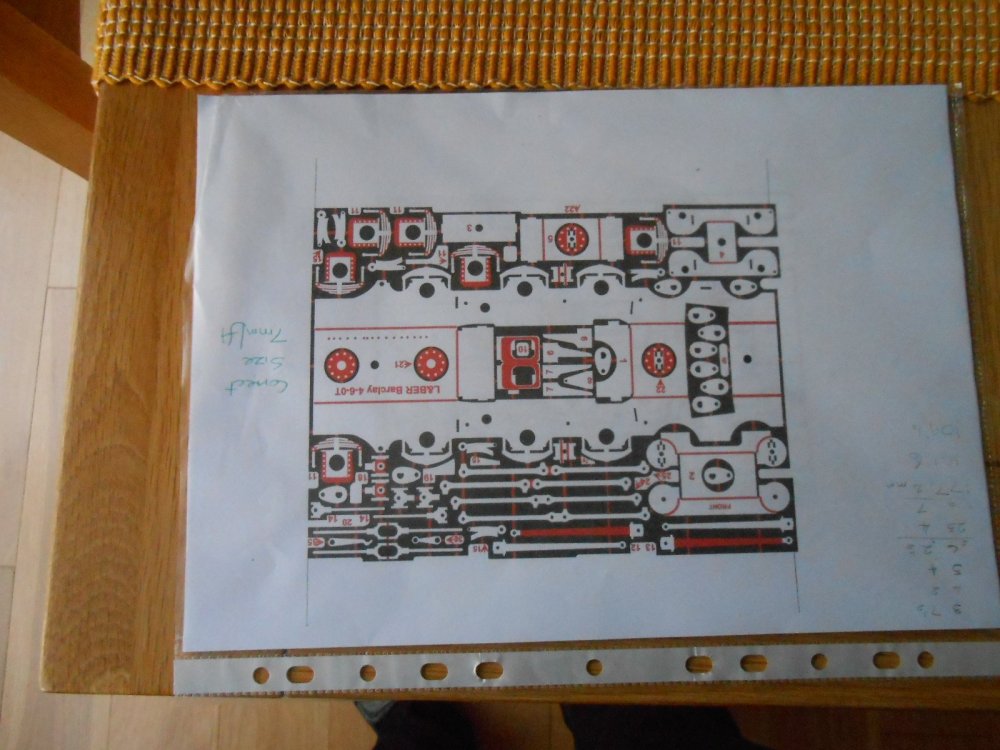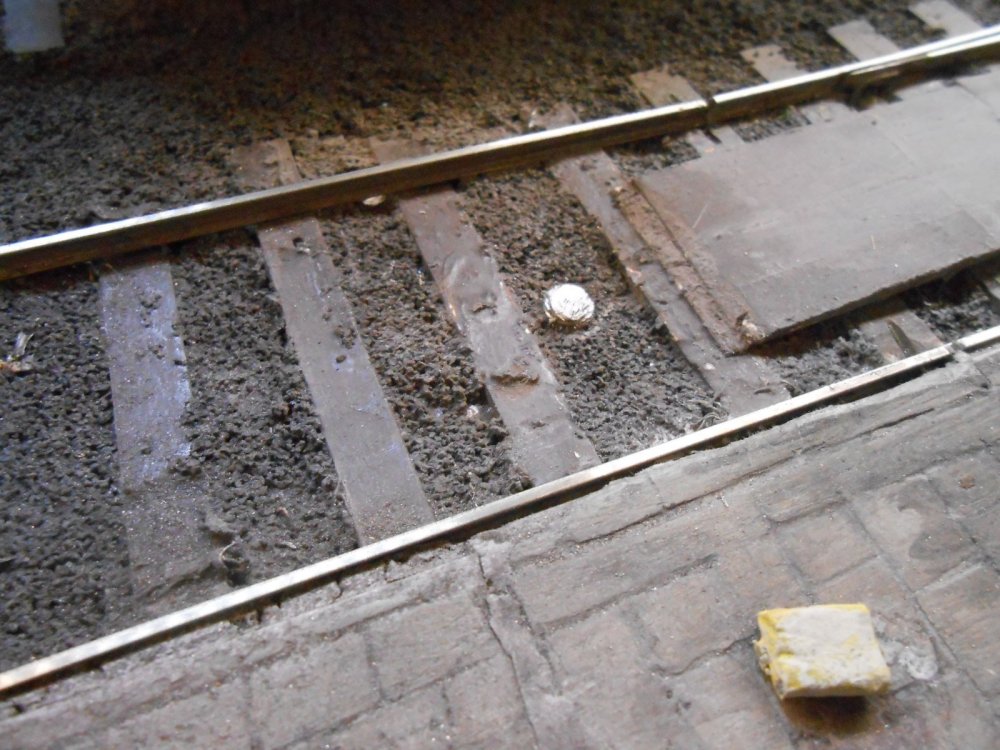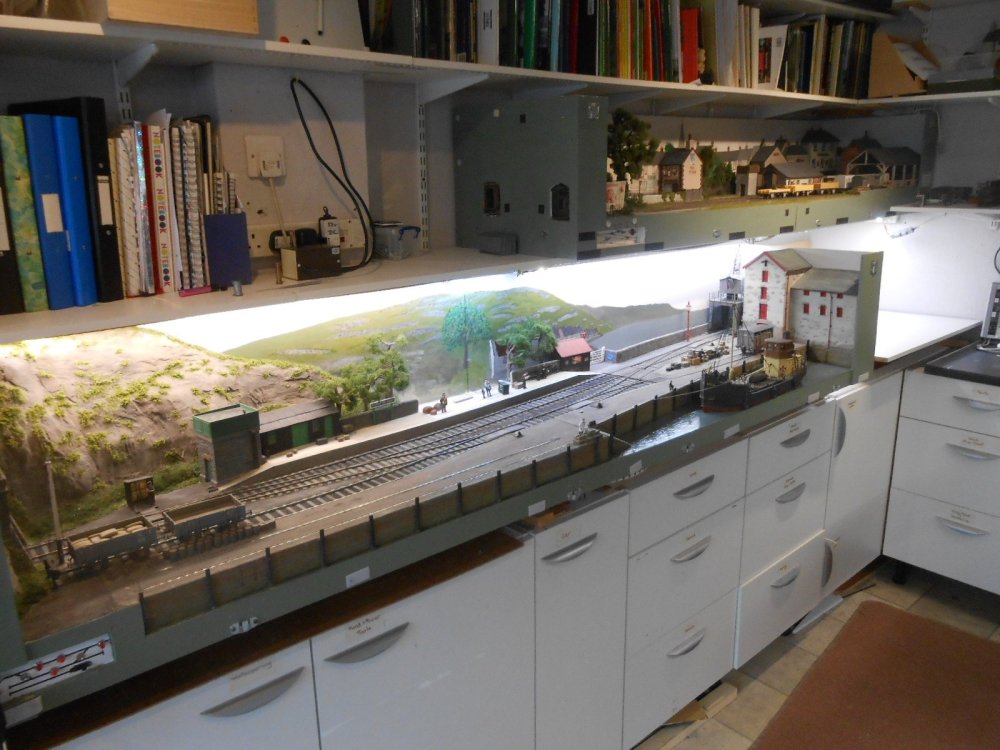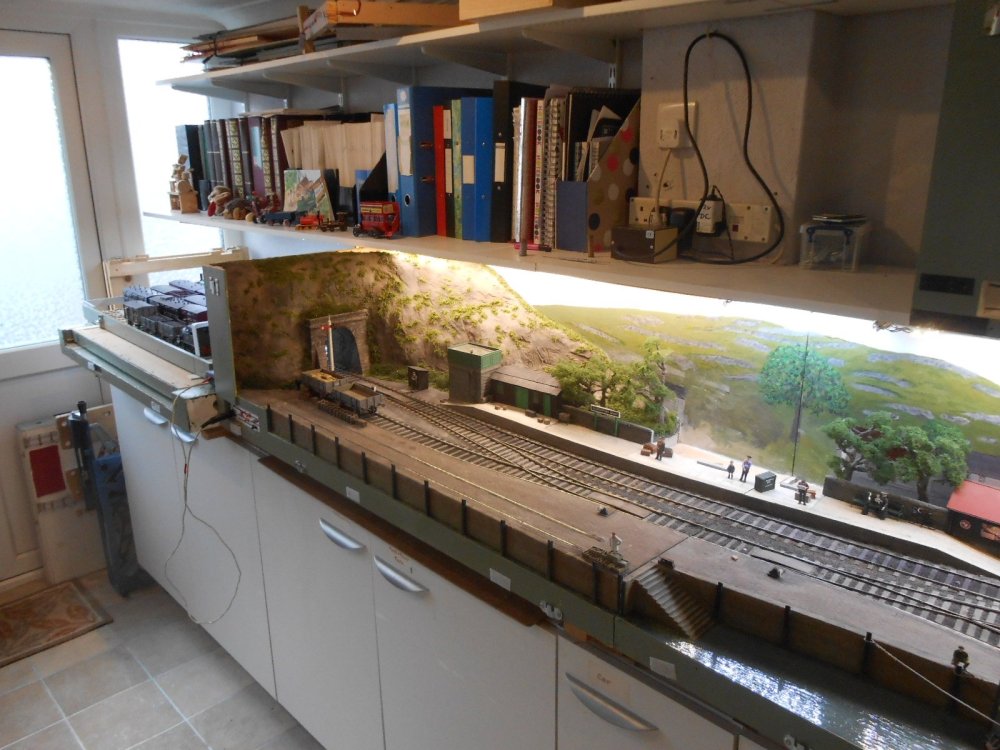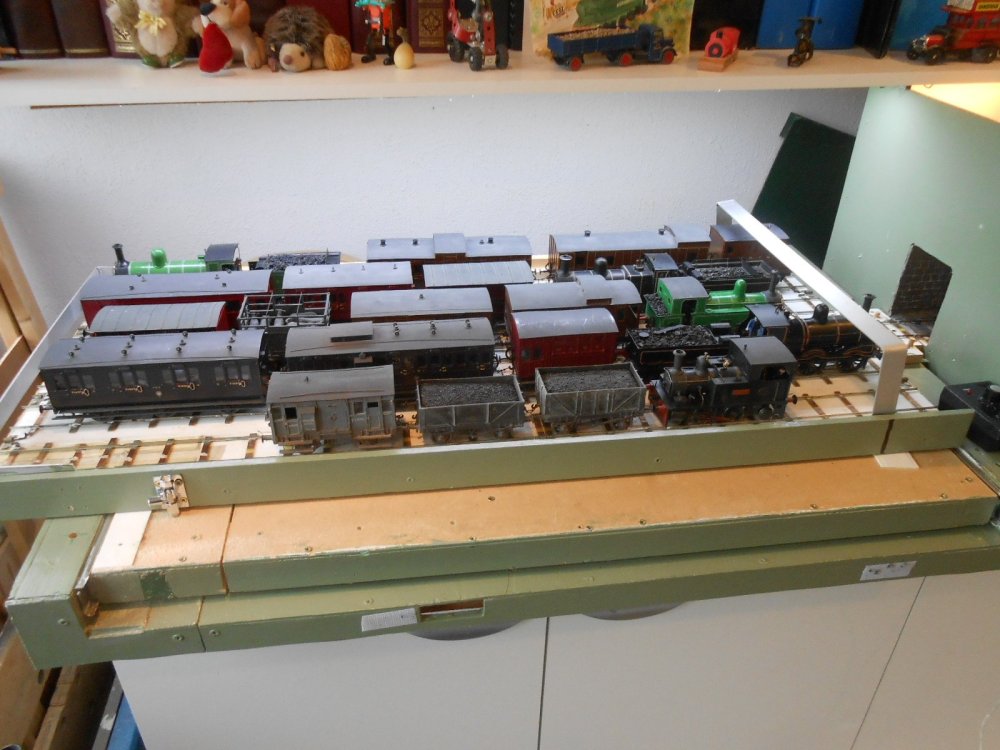
David Holman
Members-
Posts
4,359 -
Joined
-
Last visited
-
Days Won
117
Content Type
Profiles
Forums
Events
Gallery
Everything posted by David Holman
-
Some real gems there, John - especially the 4-4-0!
-
Many thanks - sounds like good advice. Heard about the Slater's wheels and am certainly thinking will use inside frames, with the outside ones dummy - probably fixed to the footplate, with the extended axles in slots and not connected to the outer frames. Am thinking the inside frames will need to have a keeper plate, so I can drop out the wheels and motor gearbox when needed.
-
Fine work and handy to know where I might get whitemetal castings for a Swilly 6 wheel coach, albeit it a way down the road for now. I use stainless steel sink cleaner on brass and nickel. A brand called Shiney Sinks was recommended back in the day, but Cif or similar works well enough with an old toothbrush.
-
I'm going to be adapting Fintonagh - mainly just a few new low relief buildings and new backscene. The track is hand built, using Peco Code 83 flat bottomed rail on copperclad sleepers. It uses 4mm finescale standards = one millimetre flangeways on the points. Both 0 and 00 wheels seem happy with this combination.
-
All about framing and the right materials. 6mm birchwood ply is the best I've found for flat surfaces and frames, but there are many options. Try getting hold of books like Iain Rice's Cameo Layouts for ideas.
- 58 replies
-
- 3
-

-
- 1950s to 1990s irish railways
- harcourt street line
- (and 3 more)
-
Post Uckfield, have managed to get back to my new narrow gauge projects & in particular the Swilly brake coach. And what an interesting time it has been! Indeed, have had to vacate the workshop for the second afternoon running having tipped over a bottle of DI Lemonine solvent. Yesterday, I did the same thing with a bottle of MEK, which was even worse. Anyway, back to Monday, when I was hoping to get the panelling done on the other side of the coach, only to find that my stock of 20x40 micro strip had virtually run out. Never mind, I thought and initially went to the Amazon website to get some more Evergreen strip. Bad idea! They were asking £18 a packet [yes, really]. Fortunately, other outlets are available, not least Slaters Plasticard, who not only do a packet for under a fiver, but it contains 50 strips to the ten from Evergreen. Ordered Monday morning, arrived Tuesday lunchtime. Can't be bad. So far, so good. While waiting for it to arrive, I decided I could have a go at the Alphagraphix bogie/underframe kit. However, while the castings are nice enough, when made up, the are a scale 6' wide and will not fit between the sole bars. I tried various ideas to cut them down, using most of my tools, until finally realised that I needed to shorten both the centre spacer and the axles ends too. The picture below sums up the chaos nicely... Since then, things have progressed well and the panelling is now complete, with the coach sitting on its bogies and awaiting the addition of the double footboards. Another problem causing much head scratching has been what to use for couplings. Kadee No5s are too short for the 2'7" wheels on Swilly stock. Thought about using AJs, but these won't work with the centre buffing couplers, so am probably going to have to try Kaydee 0n3 type or even 0 gauge ones. My mind has also been turning to building a Londonderry & Lough Swilly locomotive. First choice is one of the Andrew Barclay 4-6-0Ts, not least because Worsley Works do a 7mm scale body kit. An order has been made though it will be a while as it is currently not in stock. However, I can make a start on the chassis, especially as Roger Cromblehome at Alphagraphix kindly sent me his CAD drawing. So, more stirring of the grey matter because, as you might expect, things are far from straightforward. The main problem is that these locos were outside framed and as far I can tell the right combination of wheels, extended axles and cranks are not available. Alan Gibson do a 6' diameter, 4mm scale driving wheel that is a close match to 3'6 in 7mm scale. These come in a £10 a pair. Slaters do a standard gauge 3'6 wheel, but these are now close to £30 an axle! Gibson wheels use a 1/8th inch axle, whereas Slaters are 3/16th. Gibson are unable to supply an extended axle for 21mm gauge and though Slaters do an extended axle for outside cranks, it is way too long for 3' gauge. So, what to do?After MUCH pondering, finally came up with the idea of sourcing my own 1/8th inch steel rod and cutting it to length myself. However, a different alternative might be to use Slater's coach/wagon axles, which are long enough to go through the outside frames, while the 1.8mm extensions on to which the wheels are fitted could actually be ideal to take the outside cranks. Still with me? I'm not sure I am, but this is where I have got to at the moment, so orders for Gibson wheels, bearings, motor-gearbox and so on are being prepared, while Geoff Holt's excellent books on loco construction are being pored over again. He's not done outside frames though, so John Ahern's Miniature Locomotive Construction, first published in 1949 [mine is from 1971] may also be useful. Watch this space, as they say. Below is a photo of the loco, Roger's frame drawings and my idea of Slater's wagon axles against 3' gauge wagon wheels. The Gibson wheels, being 4mm scale have 24 spokes [drivers] and 12 spokes [bogie], Swilly ones were 12 and six respectively, so may have to remove alternate spokes, though probably only on the bogie wheels as the drivers will pretty much be hidden behind the frames. Life is complicated, that's why it's fun. Allegedly...
-
A 7mm scale etched brass kit of a permanent way ' riding van', used in track lifting trains in Ireland. £40.00, plus wheels and couplings. www.alphagraphix.co.uk
-
Fantastic thread and great to see a 12" to the foot project documented.
-
Very tasty indeed - quite a line up!
-
N Scale Ballywillan, Co Longford.
David Holman replied to Kevin Sweeney's topic in Irish Model Layouts
Hard to believe that is 2mm scale... -
Seems there has been a fair bit of interest in Belmullet, including approaching 600 views on the 'free to a good home' page. Several folk has asked for more info, so there is now a queue and am hoping to be able to find a new owner soon. Many thanks for all the positive comments.
-
Uckfield was indeed a fine show. For me, the stand out layouts were Farringdon and Longwood Edge - the latter one of Iain Rice's final projects. It was a real stunner and [typical of Rice] a very clever, two level design, packing a huge amount of interest into a small space. NPQ did ok for a first proper outing, but came away with a list of things that need work: Two of the push to make switches that operate the uncoupling magnets failed over the weekend. Given that they were the two most used ones, this perhaps points to the fact that more robust versions might be needed. They have been replaced, like for like, but may remain a problem waiting to happen. Back in the workshop, the magnet in the loop still wasn't working satisfactorily & after a fair bit of frustration this week, finally realised that the M5 bolt which forms the core of the electromagnet was sitting too low. Only a millimetre or so, but enough cause some of the the couplings to not work properly. Bit of a bummer, but there you go. At least it was easy to fix. The other main issue centred around the fiddle yard. I'd done lots of test running in the workshop, but only shunting on the layout itself, as there was no room to set the whole thing up without taking over the lounge. Ok when the Domestic Authority is out but not really practical. So, finally bit the bullet and took Belmullet to the Club storage tunnel in Chatham Historic Dockyard, so I could set up NPQ in the workshop. The fiddle yard has received some serious surgery this week: The main frame has had about 5cm sawn off its sides, so it is both lighter and sits better on the support beams. The train table has been shortened by about 15cm and also been made narrower, so it now only has five tracks in stead of seven. The also reduces weight, but makes it more manageable too. 7mm scale trains [even short ones] are heavy and rotating the fully loaded table was proving to be a two person job - rather stressful too. I'll still be taking six or seven train out to shows, but two will be spares that can vary the sequence during the day. I had several couplings fail over Uckfield and it is easier to swap an item of stock than try to repair it while exhibiting! The photos below show the revised set up in my workshop. It also means I can alternate NPQ with Fintonagh, especially once I have adapted the train table to take 21mm gauge rails inside the 36.75mm ones. Anyway, the 1900s sequence now seems to operate more reliably in terms of the AJ auto-couplings, so fingers crossed for the Portsmouth Show in three weeks time. The GSWR goods has been replaced with a one of MGWR flavour with the E class 0-6-0T, 'glasshouse brake', 4w fish van and cattle wagon with one of Richard Chown's Dublin & Meath brake vans bringing up the rear. The cattle van is swapped with another in the right hand siding and the improved magnet makes this much more effective.
- 242 replies
-
- 13
-

-
Love the roof fixing idea! Will definitely be looked at for my Swilly coaches.
-
Details just posted in the Layouts section. Available free, to the right person or group, willing to take it on. No locos or stock, though a few items could be available for purchase to get the new owner started. Check the details, look through the layout posts and if interested, send me a personal message. David Holman
- 1 reply
-
- 3
-

-

-
After much pondering, I have decided to offer Belmullet a new home, so would be keen in hearing from anyone interested in taking it over. In other words, it is available free of charge The simple reason for this is that it is 7mm scale 36.75mm gauge [correct 5'3] and while I may be willing to sell a small amount of stock [see later], essentially whoever takes it on needs to be able to build/commission their own stuff to run on it. Other things any new owner needs to be aware of are: The layout comprises three scenic boards, each 120cm x 62cm The new owner will need to build a new fiddle yard, as Belmullet's original one is now being used with Northport Quay. In its intended terminus-fiddle yard mode, the overall space required will be 5m x 0.6m, although there is no reason why it couldn't be extended into something bigger. I live in Kent, which is a long way from Ireland, to say nothing of the expensive ferry fares. The new owner will need to collect it from my house, though it should fit in a reasonable hatchback/estate car, requiring an overall space of 120cm x 90cm x 45cm when crated up for transport. If it went to someone in the UK, I might be able to help with delivery if not too far away. Points and signals [with bounce effect] are worked from a custom made Megapoints panel using servos via small mother boards on the layout. This comes with its own transformer. For working the trains, the new owner will need to provide their own controller and transformer. The layout is wired to run from a Gaugemaster hand held unit, via a 5 pin DIN plug. The layout can be operated from either the front or the rear The layout sits on longitudinal beams [on top of kitchen base units] in my workshop, so the new owner would need to provide their own supports Although originally built for my Arigna Town layout, ten years or so ago, the baseboards are structurally very sound and [since conversion to Belmullet], all the scenics were renewed and most of the buildings are only two-four years old. Track is Code 100 flat-bottomed rail on copper clad sleepers. Points were all made by Marcway of Sheffield, while the plain track was built by me. The turnable works from a simple hand cranked mechanism. Please note: this is not a layout for anyone looking for an instant 'train set'. It has been built to a decent standard, requiring hundreds, if not thousands of hours, of my own time and skill. Any new owner will need to be competent in carpentry, basic electrics, soldering and general modelling skills. On this basis, it might make an interesting Club or group project. The reason I am willing to let Belmullet go, is simply because I need the space in my workshop. The layout was built to be an exhibition layout, but after just a single outing, I realised it was too much effort for me to take out and it seems a shame for it not to be used. Stock While, for reasons already explained, I am not asking any money for Belmullet, were I to provide any stock, this would have to be paid for, not least because locos coaches and wagons would be fairly easy to sell on and I have no intention of being that charitable! The items that could be for sale are as follows Midland Great Western J19 0-6-0. Built from an Alphagraphix/Tyrconnel brass kit. Price £300, being solely the cost of the kit, plus motor, gears and wheels Deutz, G class, 4 wheel diesel shunter. Built from a set of Worsley Works etches, with much added detail. Price £180, as above Up to 15 four wheel open wagons and vans, all scratch built by me representing SLNCR, MGW and GS&W prototypes. The new owner will need to decide on their own couplings. I have used three links, Dinghams and Alex Jacksons over the years, so these vehicles currently are a mixture of the above - or none at all. I am willing to sell these at £15 each. Bearing in mind 7mm scale wagon wheels cost £10 per vehicle, while cast buffers, W irons and brake gear are each at least £5 a set, along with both locos, a new owner would get my time, effort and skill for free. So, there you are. If anyone is interested, I suggest you first look through all the posts on this thread, in order to get a feel for the layout. After that, send me a personal message if you wish to discuss things further. I need to be confident that whoever takes the layout on will be able to enjoy it and not simply someone wanting it for profit. Everything is in working order, though it has only been operated occasionally over the last two years.
- 179 replies
-
- 15
-

-

-
The cup holder you mean!? My wife likes the picture and I quite like the cupholder. NPQ doesn't have a tea shelf (unlike Fintonagh), so definitely need to add something b before the next show.
-
Some impressive carpentry there!
- 60 replies
-
- 2
-

-

-
Lovely to see you Joe - though not sure about the photo!
-
Super pictures making a fine memory of a lovely day! The visiting SLNCR stock is every bit as good as it looks here and it was great to have them all, along with the three bogies too. Overall, not bad for a first outing and the experience will hopefully make it better next time. That will be Portsmouth, on 18th November.
-
Not the worst day, but not the best either... A bit like Belmullet's debut two years ago, a couple of annoying problems blighted much of the day. First was a dry joint on the entry track to the fiddle yard, but the major problem was a trestle in the wrong place, which caused both a serious ridge between the two scenic boards and put a bit of a gradient in the fiddle yard itself. Unfortunately, the latter had to wait until late in the day before there was nobody around and could empty the train table and remove the fiddle yard base so the offending trestle could be shifted to the right place. As a result, both 0-6-0s tried to detail at the baseboard joint, as did some of the 6w coaches. Thankfully, shorter wheel base and bogie stock was not affected, though a push to make switch for the uncoupling magnet in the loop seems to have failed and will need to be replaced in the morning... 1950s day tomorrow, when we hope to have no less than five Sligo Leitrim tanks on show.
- 242 replies
-
- 10
-

-

-
Probably the best show in SE England, though not because Northport Quay debuts there tomorrow! No less than five Iain Rice layouts, plus others and excellent trade and society stands. Well worth a visit if you are in the area.
-
So they are! Seriously cool dudes, or a posed picture? Either way an interesting option for a couple of ModelU figures....
-
Might be worth considering the DAS clay route, as you can scribe the mortar lines across the corners... The main issue with adding extra detail is that it then means you need to do the same for everything else on the layout, increasing building time even more. However, if that brings satisfaction, then why not? Our hobby caters for all tastes - builders, operators and all points in between. The standard of ready to run models is fantastic these days, so why not aim to present them against matching buildings and scenery? Nothing wrong with trying to improve skills and sometimes this can be about being a 'smarter' modeller. Back in the day, I used Howard Scenics embossed card for brickwork. Still available and sometimes still use it, because it is quicker than scribing a whole building. However, I long since have up painting all the bricks individually (I know!), because I learned about easier, quicker ways!I Perhaps it all boils down to the 'two foot rule', because if it can't be see from this distance, then is it worth the effort?
-
Proof that the image quality of early cameras could be fantastic.
-
Thanks folks, though I feel the same way about CAD, Ken. Happier to stick with what I know!
.png.c363cdf5c3fb7955cd92a55eb6dbbae0.png)

